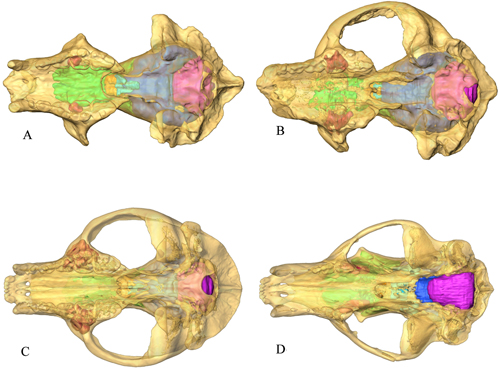| Location: Home > Research > Research Progress |
| Cranial Endocasts Supporting Giant Pandas Evolved As an Independent Family |
|
Virtual endocrania of Ailuropoda microta(A), the Late Pleistocene A. baconi (B),
Dong Wei and Zhang Juefei, Paleontologists from Institute of Vertebrate Paleontology and Paleoanthropology (IVPP), Chinese Academy of Sciences, recently described the morphology of endocranial cavities of giant pandas, compared them with that of the polar bear, and interpreted the evolution of the endocranial cavity of giant pandas, as reported in the latest issue of Vertebrata PalAsiatic 2011(2). “The rarity of natural endocranial casts compared with other fossil materials such as teeth, as well as forbiddance of destructive dissection on precious skulls, surely has hindered paleoneurological research”, said Dong and Zhang, “recent development of computed tomography (CT) and three dimensional visualization techniques has allowed paleontologists to noninvasively explore endocranial morphology on rare and precious fossil skulls and undertake quantitative analyses.” Three-dimensional virtual cranial endocasts of the Early Pleistocene Ailuropoda microta, the Late Pleistocene A. baconi, extant A. melanoleuca and Ursus maritimus were described and compared. The morphologies of cranial endocasts of giant pandas are generally similar to each other, but quite different from that of the polar bear. The intracranial volumes appear the smallest in A. microta, intermediate in A. melanoleuca, and the largest in A. baconi. The sulci and gyri impressions are developed on cranial endocasts of the giant pandas, more so in A. melanoleuca than in A. microta. On the contrary, they are not developed on the cranial endocast of the polar bear, but the blood vessel impressions are developed on the lateral occipital sides in the polar bears. The ventral longitudinal groove on olfactory endocast is developed in A. microta, weak in A. baconi, nearly absent in A. melanoleuca, but well developed in Ursus maritimus. The encephalization quotient is similar among A. microta, A. baconi and A. melanoleuca, but it is much greater for giant pandas than in the polar bear. The morphology of the paranasal sinuses is also similar among giant pandas, but different from that of the polar bear. The frontal sinuses of giant pandas are rather long, quite high and dorsally ridgy, but those of the polar bear are shorter, relatively lower, wider and dorsally flat. The maxillary sinuses of giant pandas are relatively wide, but those of the polar bear are narrow. The sphenoid sinuses of giant pandas are all small, but those of the polar bear are large and cover the anterior portion of the braincase. Dong and Zhang said, “These endocranial differences between giant pandas and the polar bear support the classification of giant pandas as an independent family.”
|
